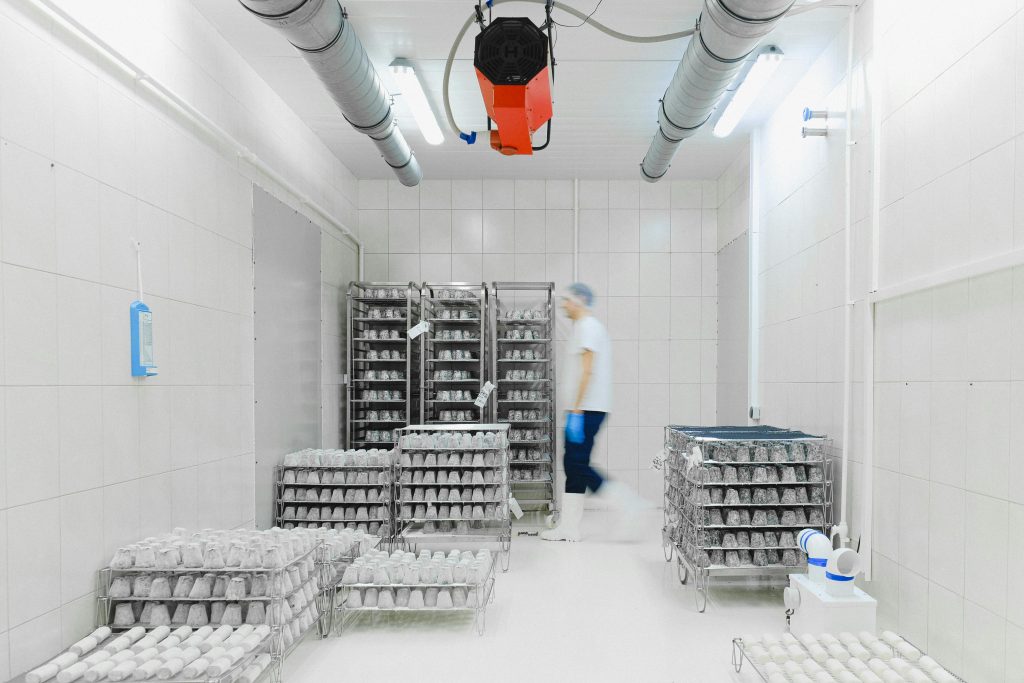
In the fast-paced world of food and pharmaceutical industries, cold storage systems play a crucial role in preserving the quality and safety of temperature-sensitive products. This guide explores the applications, essential design criteria, and machinery selection process for an efficient cold storage system.
What is a Cold Storage System?
A cold storage system is a specialized facility designed to store perishable goods under controlled temperature and humidity conditions. These systems are vital for industries such as food, pharmaceuticals, agriculture, and chemicals.

Applications of Cold Storage Systems
- Food Industry: Preserving fruits, vegetables, meat, and seafood to maintain freshness and extend shelf life.
- Pharmaceuticals: Storing vaccines, medicines, and biological products under precise temperature controls.
- Agriculture: Preventing spoilage of crops and maintaining quality during transit and storage.
- Dairy Products: Ensuring the integrity of milk, cheese, and other dairy goods.
Key Design Criteria for Cold Storage Systems
To ensure efficiency and reliability, the design of a cold storage system must consider the following factors:
- Temperature Range:
- Define the required temperature range based on stored products (e.g., -18°C for frozen goods, 2-8°C for chilled goods).
- Storage Capacity:
- Calculate the volume of goods to be stored and plan for future scalability.
- Insulation:
- Use high-quality insulation materials like polyurethane (PU) panels to reduce heat transfer and energy consumption.
- Ventilation and Humidity Control:
- Maintain optimal airflow and control humidity to prevent product deterioration.
- Energy Efficiency:
- Incorporate energy-saving technologies, such as variable frequency drives (VFDs), to minimize operational costs.
- Flooring and Walls:
- Choose durable, non-slip flooring and insulated walls to ensure safety and temperature control.
Machinery Selection for Cold Storage Systems
Proper equipment selection is crucial for the functionality of a cold storage system.
- Refrigeration Compressors:
- Brands like Bitzer, Emerson, and Copeland offer reliable compressors for maintaining desired temperatures.
- Evaporators and Condensers:
- Opt for high-efficiency models to ensure effective heat exchange.
- Temperature Control Systems:
- Advanced digital controllers help monitor and maintain precise temperature levels.
- Backup Generators:
- Provide an uninterrupted power supply during outages.
- Cold Storage Racking Systems:
- Optimize storage space and improve accessibility with customizable racking systems.

Steps to Build a Cold Storage System
- Assessment and Feasibility Study:
- Analyze the types and volume of products to determine storage needs.
- Site Selection:
- Choose a location with easy logistics access and suitable climatic conditions.
- System Design and Layout:
- Develop a layout that maximizes space utilization while ensuring smooth workflow.
- Machinery Installation:
- Select and install equipment tailored to operational requirements.
- Testing and Commissioning:
- Conduct performance tests to ensure the system meets design specifications.
Benefits of Cold Storage Systems
- Extends the shelf life of perishable goods.
- Maintains product quality and safety.
- Reduces wastage and financial losses.
- Enables compliance with industry regulations.
- Supports business expansion into temperature-sensitive products.
Engineering Guide to Cold Storage Systems
Cold storage systems are essential engineering solutions for preserving perishable goods. Their design and operation require precise calculations, robust machinery, and adherence to technical standards. Below are detailed technical insights to help design and operate an efficient cold storage system.
1. Temperature and Humidity Control
- Temperature Zones:
- Chilled Storage: 0°C to 4°C (ideal for dairy, fruits, and vegetables).
- Frozen Storage: -18°C to -30°C (ideal for meat, seafood, and ice cream).
- Deep Freezing: Below -30°C (for long-term storage).
- Humidity Range:
- Maintain 85%-95% relative humidity for fruits and vegetables.
- Lower humidity for frozen goods to prevent ice accumulation.

2. Heat Load Calculation
Heat load estimation ensures the refrigeration system can handle cooling requirements effectively. Below are the contributing factors:
a. Heat Sources in Cold Storage:
- External Heat Infiltration: Through walls, doors, and ceilings due to temperature differences.
- Product Load: Heat brought by the products during loading.
- Internal Equipment: Heat generated by lighting and machinery.
- Personnel Heat: Heat from workers operating inside.
b. Heat Load Formula:
Q=U×A×ΔTQ=U×A×ΔT
Where:
- QQ = Heat load (kW)
- UU = Overall heat transfer coefficient (W/m²·K)
- AA = Surface area (m²)
- ΔTΔT = Temperature difference between inside and outside (°C)
c. Example Calculation:
For a 100 m² cold room with a wall UU-value of 0.25 W/m²·K and a temperature difference of 25°C:Q=0.25×100×25=625 W (0.625 kW)Q=0.25×100×25=625W(0.625 kW)
Additional Considerations:
- Add 10%-20% safety margin for unforeseen loads.
- Include product-specific cooling load and air circulation impact.
3. Insulation Material Selection
- Polyurethane (PU) Panels: High thermal resistance (R-value) and lightweight.
- Expanded Polystyrene (EPS): Cost-effective but less durable.
- Thickness:
- Chilled storage: 100 mm
- Frozen storage: 150 mm
- Deep freezing: 200 mm

4. Refrigeration Machinery Selection
a. Compressors:
- Reciprocating Compressors: Suitable for small to medium storage.
- Screw Compressors: High efficiency for large-scale applications.
- Brands: Bitzer, Emerson, Copeland (Bitzer).
b. Condensers:
- Air-Cooled Condensers: Ideal for small setups.
- Water-Cooled Condensers: For large, high-efficiency systems.
c. Evaporators:
- Select models with fin spacing to prevent frost buildup.
- Ensure airflow is adequate for uniform cooling.
d. Expansion Devices:
- Thermostatic or electronic expansion valves control refrigerant flow precisely.
5. Engineering Design Considerations
a. Floor Design:
- Material: Reinforced concrete with non-slip epoxy coating.
- Load Capacity: Designed for heavy racking and forklifts.
- Drainage: Sloped floors for water drainage.
b. Wall and Ceiling:
- Use pre-insulated PU panels for walls and ceilings.
- Seal joints to prevent air leaks and moisture infiltration.
c. Ventilation System:
- Install ventilation fans for air circulation and humidity control.
- Maintain positive pressure to reduce external air infiltration.
d. Door Selection:
- Sliding or Hinged Doors: Minimize energy loss during opening.
- Air Curtains: Prevent warm air entry during door operation.
6. Energy Efficiency Measures
- Use LED lighting to reduce heat generation and energy consumption.
- Install Variable Frequency Drives (VFDs) for compressors and fans.
- Regular maintenance of refrigeration units to prevent performance degradation.
- Automate temperature and humidity controls with smart systems.
7. Monitoring and Safety Systems
- Temperature Monitoring: Install sensors and automated alarms for deviations.
- Backup Systems: Use standby compressors and generators for uninterrupted operation.
- Fire Safety: Ensure compliance with fire regulations, including sprinklers and extinguishers.
8. Industry Standards
- Comply with ASHRAE standards for refrigeration and HVAC systems.
- Follow HACCP and ISO 22000 guidelines for food safety.
How to Decide the Required Capacity of a Cold Storage for a Manufacturing Industry or Factory
Determining the required capacity of a cold storage facility is a critical process that involves analyzing storage needs, production workflows, and operational constraints. Below is a step-by-step guide to help you calculate and finalize the capacity for your manufacturing industry or factory:
1. Understand Storage Requirements
a. Type of Products Stored
- Identify whether the facility will store raw materials, semi-processed goods, or finished products.
- Examples:
- Meat and seafood: Frozen at -18°C to -30°C.
- Dairy and fruits: Chilled at 0°C to 4°C.
b. Volume of Products
- Estimate the daily input and storage duration.
- Example: If 500 kg of meat is produced daily and stored for 7 days, the required storage capacity is:500 kg/day×7 days=3500 kg.500kg/day×7days=3500kg.
c. Packaging and Palletization
- Consider the packaging type (boxes, pallets, crates) to calculate the space each unit occupies.
2. Calculate Total Storage Volume
a. Product Density
- Determine the density of the stored products to assess volume.
- Example:
- Meat density = 0.9 kg/m³.
- For 3500 kg of meat:Required Volume=35000.9≈3889 m³.Required Volume=0.93500≈3889m³.
- Example:
b. Space Utilization Factor
- Account for air circulation and accessibility. Typically, 70%-85% of the storage volume is usable.
c. Final Volume Calculation
For 3889 m³ with 80% utilization:Final Volume=38890.8≈4861 m³.Final Volume=0.83889≈4861m³.
3. Evaluate Production and Turnover Rates
- Analyze how frequently products are added or removed.
- High turnover rate: Requires smaller storage capacity with efficient logistics.
- Low turnover rate: Needs larger capacity for prolonged storage.
4. Consider Future Expansion
- Anticipate production growth over 5-10 years. Add 10%-20% extra capacity to the current calculation to accommodate expansion.
5. Design Criteria for Cold Storage Capacity
a. Storage Conditions
- Define temperature and humidity levels required for the products.
b. Room Layout
- Choose between single-chamber (for uniform products) or multi-chamber (for varied products).
c. Racking System
- Optimize the racking system to maximize vertical space.
- Example: For a 5-meter ceiling height, double-stacked pallets can double storage capacity.
d. Insulation
- Insulation thickness impacts the size of machinery and energy efficiency.
6. Machinery and Heat Load Analysis
a. Cooling Load Calculation
Cooling load includes:
- Product heat load (heat brought in by products).
- Heat infiltration through walls, floors, and doors.
- Heat from equipment and personnel.
b. Machinery Selection
- Match the refrigeration capacity with cooling load.
- Allow for standby systems for redundancy.
7. Compliance with Standards
- Follow industry standards such as ASHRAE for refrigeration.
- Ensure food safety guidelines like HACCP and ISO 22000 are met.
Example Calculation
For a factory processing 2 tons of fish daily and storing for 10 days:
- Daily input: 2000 kg/day.
- Storage duration: 10 days.
- Total storage requirement:2000 kg/day×10 days=20,000 kg.2000kg/day×10days=20,000kg.
- Product density: Fish (1 kg/m³):20,0001=20,000 m³.120,000=20,000m³.
- With 80% utilization:20,0000.8=25,000 m³.0.820,000=25,000m³.
- Future growth (20%):25,000×1.2=30,000 m³.25,000×1.2=30,000m³.
Final capacity = 30,000 m³ with machinery sized to handle this cooling load.
Popular Cold Storage System Providers
- Immenso Bangladesh: A leading supplier of cold storage solutions in Bangladesh, offering customized systems for various industries. Visit their website.

